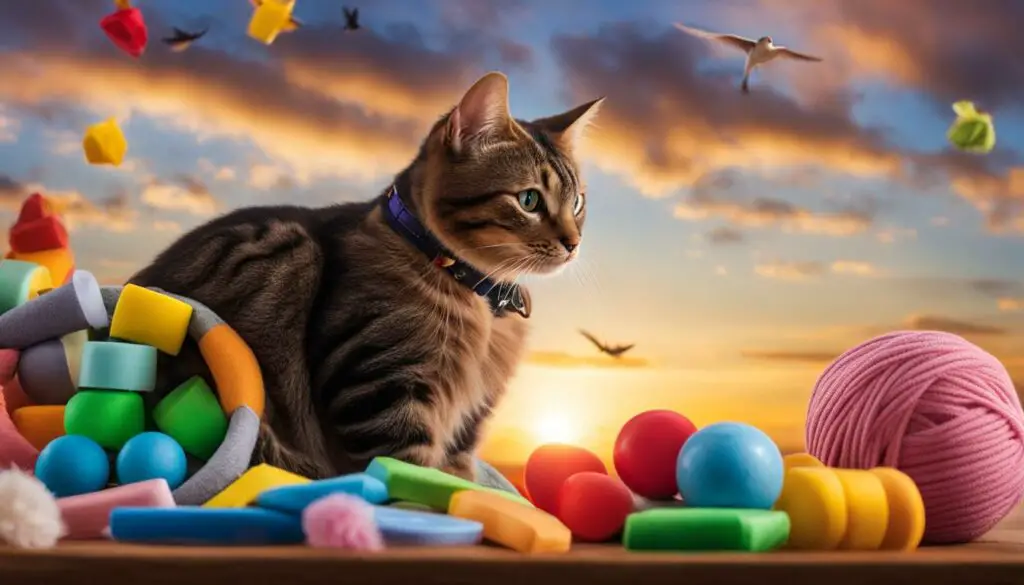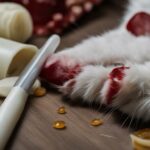As a cat owner, one of the challenges you may face is preventing your furry friend from licking their stitches after surgery. While traditional plastic cone collars are commonly used for this purpose, there are alternative options available that can be more comfortable for your cat. In this article, I will share some tips and tricks on how to keep your cat from licking their stitches without the cone of shame.
It’s important to prevent cats from licking their stitches to avoid infection and delayed healing. Excessive licking can remove stitches, cause irritation, and hinder the recovery process. Fortunately, there are several methods that can help you achieve this goal.
Key Takeaways:
- Traditional plastic cone collars, also known as “cones of shame,” are commonly used to prevent cats from licking their stitches after surgery.
- Alternative options to plastic cones include inflatable collars, soft E-collars, neck brace collars, covering the wound with fabric, and providing distractions for the cat.
- Proper aftercare and prevention of licking are essential for promoting the healing process and preventing infection.
- Inflatable collars, soft E-collars, and neck brace collars offer more comfortable alternatives to traditional plastic cones.
- Distractions such as toys and treats can redirect the cat’s attention away from the wound and prevent excessive licking.
Why Do Cats Lick Their Wounds?
When cats undergo surgery or have wounds, they often have the instinct to lick them. However, this behavior can be detrimental to their recovery. Licking can delay the healing process, introduce bacteria and cause infection, and even risk removing the stitches. It’s important to understand why cats engage in this behavior and take measures to prevent excessive licking.
Cats lick their wounds for various reasons. Firstly, licking is a natural instinct for cats, rooted in their grooming behavior. When they groom themselves, they release endorphins, which provide a sense of comfort and relaxation. Additionally, licking also helps clean the wound by removing debris or dirt. However, excessive licking can cause more harm than good. The mechanical abrasion from the cat’s rough tongue can damage the delicate tissue of the wound and hinder the healing process. Furthermore, the constant moisture from saliva creates an environment conducive to bacterial growth, increasing the risk of infection.
Proper aftercare is essential in preventing cats from excessively licking their wounds. By employing alternative methods to the traditional plastic cone collar, such as inflatable collars, soft E-collars, neck brace collars, or by covering the wound with fabric, it is possible to effectively deter cats from engaging in excessive licking. These methods provide comfort to the cat while restricting their access to the wound.
It’s important to note that preventing cats from licking their wounds not only aids in their physical recovery but also prevents the risk of complications such as infection or reopening of the wound. By understanding why cats engage in this behavior and taking appropriate preventive measures, we can contribute to a smoother recovery process for our feline companions.
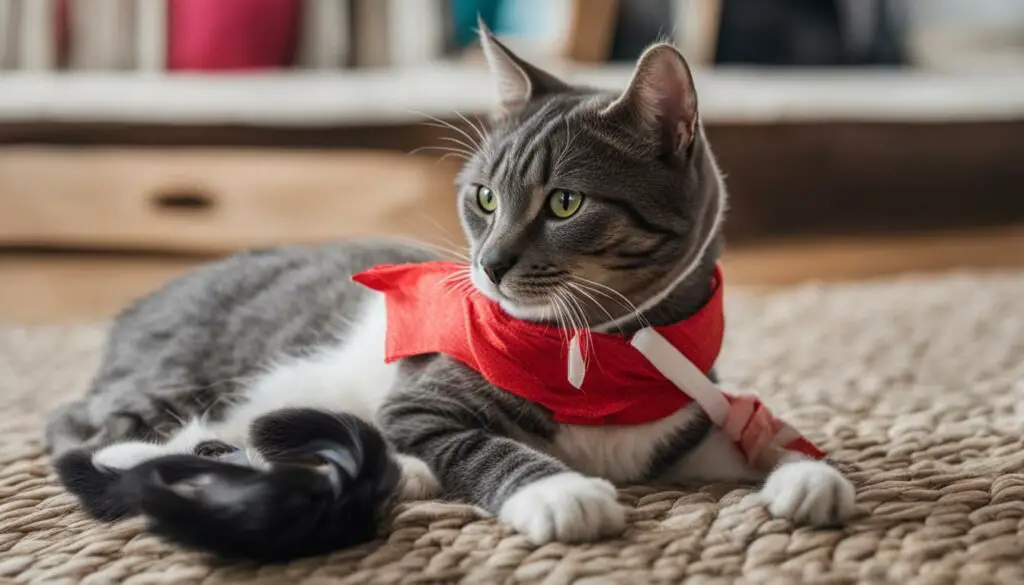
Preventing Cats from Licking Wounds
When it comes to preventing cats from licking their wounds, the use of an Elizabethan collar or “E-collar” is the most common method recommended by veterinarians. However, there are alternative options available that are more comfortable for the cat while still effectively preventing licking. These include inflatable collars, soft E-collars, and neck brace collars. It’s important to choose the appropriate size for the collar to ensure it fits properly and effectively prevents licking.
Inflatable collars are lightweight, soft, and provide greater visibility compared to traditional E-collars. They restrict the mobility of the cat’s head, preventing access to the wound. Popular brands such as the KONG Cloud Collar, Protective Inflatable Cone Collar, and Well & Good inflatable collar offer comfortable alternatives to the plastic cone.
Soft E-collars, on the other hand, are made of fabric and provide a quieter and more flexible option. They are available in various designs and are more comfortable for cats to wear. Recognized brands like Comfy Cone, E-KOMG, and Alfie Pet offer effective soft E-collar options for preventing cats from licking their wounds.
| Pros | Cons |
|---|---|
| Lightweight and soft | May not be as effective for cats determined to lick |
| Greater visibility | May require more supervision to ensure the collar stays in place |
| Comfortable for cats to wear | May not be suitable for all wound locations |
Neck brace collars are another option for preventing cats from licking their wounds. These collars have a rigid plastic exterior and a soft, padded interior. They restrict the cat’s neck movement and only allow for lateral head rotations, effectively preventing access to the wound. The BiteNot collar is a popular brand known for its effectiveness and comes in different sizes to accommodate cats of various sizes.
Inflatable Collars for Cats
When it comes to preventing cats from licking their stitches without using a traditional cone, inflatable collars are an excellent alternative. These collars are designed to restrict the mobility of the cat’s head, preventing them from reaching their wounds. They are lightweight, soft, and provide greater visibility compared to the traditional E-collars.
Some popular inflatable collar options for cat post-surgery care include the KONG Cloud Collar, Protective Inflatable Cone Collar, and Well & Good inflatable collar. These collars are designed to comfortably fit around the cat’s neck, allowing them to move around without any restrictions while still effectively preventing licking.
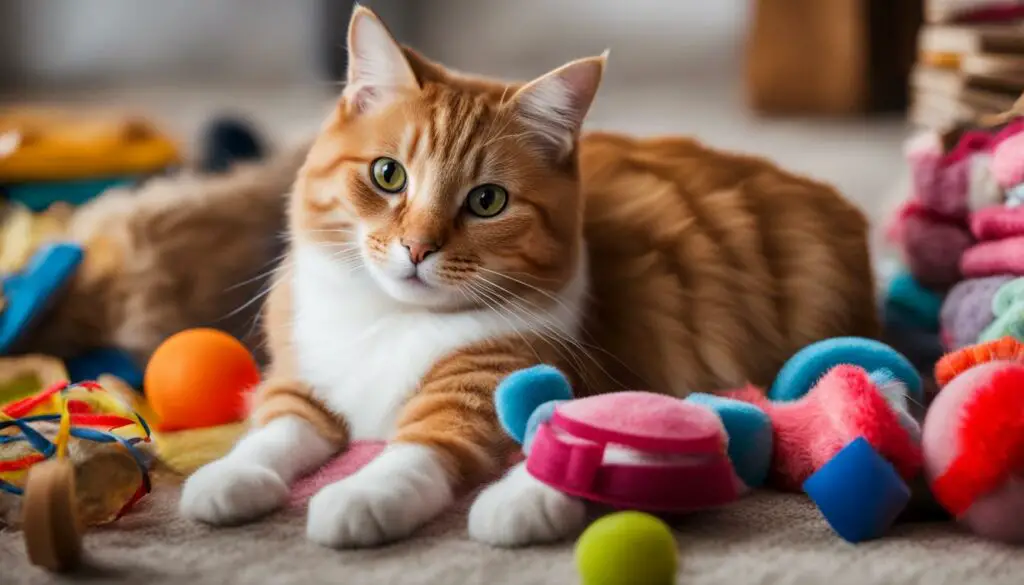
By using inflatable collars, cat owners can provide their furry friends with a more comfortable and less restrictive recovery experience. These collars not only prevent licking but also minimize stress and discomfort for the cat. They are a great option for cat owners who are looking for a more humane and practical alternative to traditional plastic cone collars.
Soft E-Collars for Cats
When it comes to preventing cats from licking their wounds, soft E-collars are a convenient and comfortable option. These fabric collars provide a quieter and more flexible alternative to traditional plastic E-collars. Not only do they effectively prevent cats from accessing their wounds, but they also allow for more natural movements and increased comfort during the healing process.
Soft E-collars are available in various designs and sizes to suit different cats and their specific needs. One popular brand is Comfy Cone, which offers a range of sizes and adjustable straps for a secure fit. E-KOMG is another recognized brand that offers soft E-collars designed to mimic the shape of traditional cones while providing the benefits of fabric collars. Additionally, Alfie Pet offers stylish soft E-collars with adorable prints, adding a touch of personality to your cat’s recovery.
The Benefits of Soft E-Collars
- Comfort: The soft and flexible material of these collars ensures a more comfortable experience for your cat compared to hard plastic cones.
- Reduced Anxiety: Soft E-collars are often less intimidating for cats, minimizing stress and anxiety during their recovery period.
- Better Visibility: Unlike traditional cones, fabric collars provide better visibility, allowing your cat to navigate their surroundings more easily.
- Improved Mobility: Soft E-collars allow for more natural movements, making it easier for your cat to eat, drink, and groom themselves without restrictions.
“Soft E-collars are a comfortable and effective alternative to traditional plastic cones. They provide the necessary protection for your cat’s wounds while allowing them to heal in comfort and style.” – Dr. Jane Adams, Veterinarian
Remember, it’s important to consult with your veterinarian to determine the most suitable collar option for your cat’s specific needs. They can provide guidance on sizing and recommend the best type of collar based on the location and severity of your cat’s wound. By choosing a soft E-collar, you can ensure your cat’s comfort during the recovery process while effectively preventing them from licking their wounds and promoting proper healing.
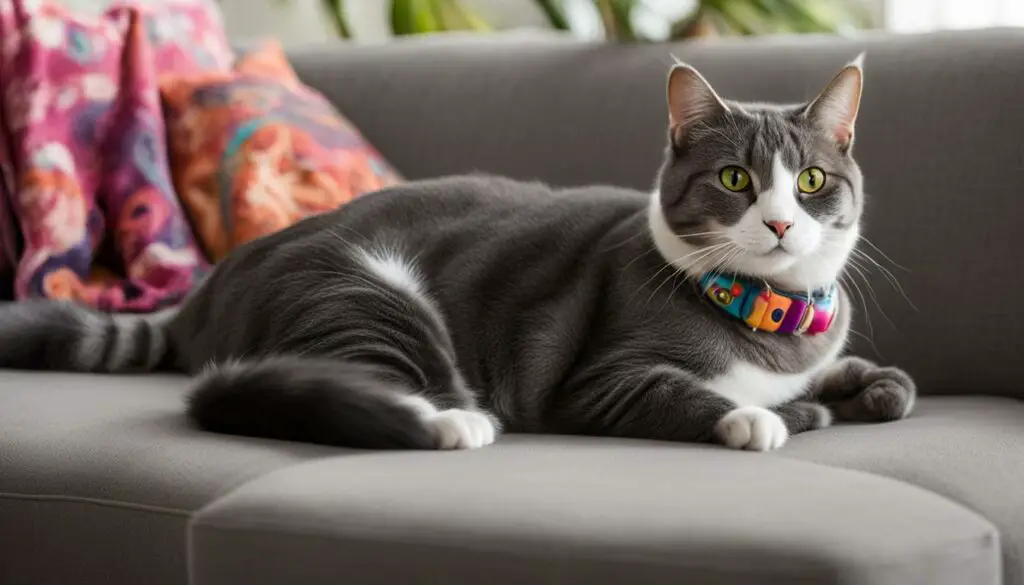
Neck Brace Collars for Cats
When it comes to protecting a cat’s wounds and aiding in their healing process, neck brace collars are an effective option to consider. These collars, also known as cervical collars, resemble neck braces used by humans. They feature a rigid plastic exterior and a soft, padded interior for the comfort of the cat.
Neck brace collars restrict the movement of the cat’s head, preventing them from bending their necks and only allowing for lateral head rotations. This restriction effectively prevents the cat from reaching their wounds and licking them. By keeping the wound protected, the collar promotes proper healing and reduces the risk of infection.
The popular BiteNot collar is a well-known brand in this category, offering different sizes to accommodate cats of various breeds and sizes. These collars are designed to be lightweight and adjustable, ensuring a secure fit that doesn’t impede the cat’s breathing or daily activities. When using a neck brace collar, it’s essential to follow the manufacturer’s instructions for proper usage and fit.
Benefits of Neck Brace Collars for Cats:
- Prevent cats from bending their necks to reach wounds
- Reduce the risk of infection and promote proper healing
- Lightweight and adjustable for a secure and comfortable fit
- Allow lateral head rotations for limited mobility
When compared to traditional plastic cone collars, neck brace collars provide a more targeted and restrictive approach to wound protection. Their design ensures that the cat cannot reach their wounds, allowing for a better recovery process. However, it’s important to note that each cat’s needs may vary, and consulting with a veterinarian is recommended to determine the most suitable option for your cat’s specific situation.
| Brand | Description |
|---|---|
| BiteNot | A popular option with different sizes available |
Table: Neck Brace Collar Brands

With the use of neck brace collars, cats can have their wounds protected while allowing for a comfortable recovery experience. These collars provide a suitable alternative to traditional cones, ensuring that the cat’s mobility and well-being are not compromised. By investing in the right collar and following proper usage guidelines, cat owners can help their pets heal effectively and prevent further complications.
Covering the Wound
When it comes to preventing cats from licking their wounds without using a cone, covering the wound with soft fabric can be an effective option. Specialized recovery body suits designed for cats are available for purchase, providing a secure and comfortable covering for the wound. Alternatively, a t-shirt, onesie, or sock can be used and secured with medical tape, ensuring the wound remains protected. However, it’s important to avoid applying tape directly to the cat’s fur to prevent discomfort or skin irritation.
Using fabric to cover the wound not only helps to prevent licking but also provides an added layer of protection against dirt and germs. It creates a physical barrier that can aid in the healing process by reducing the risk of infection. Additionally, covering the wound can help to minimize the visibility of the stitches or wound, which can be reassuring for pet owners.
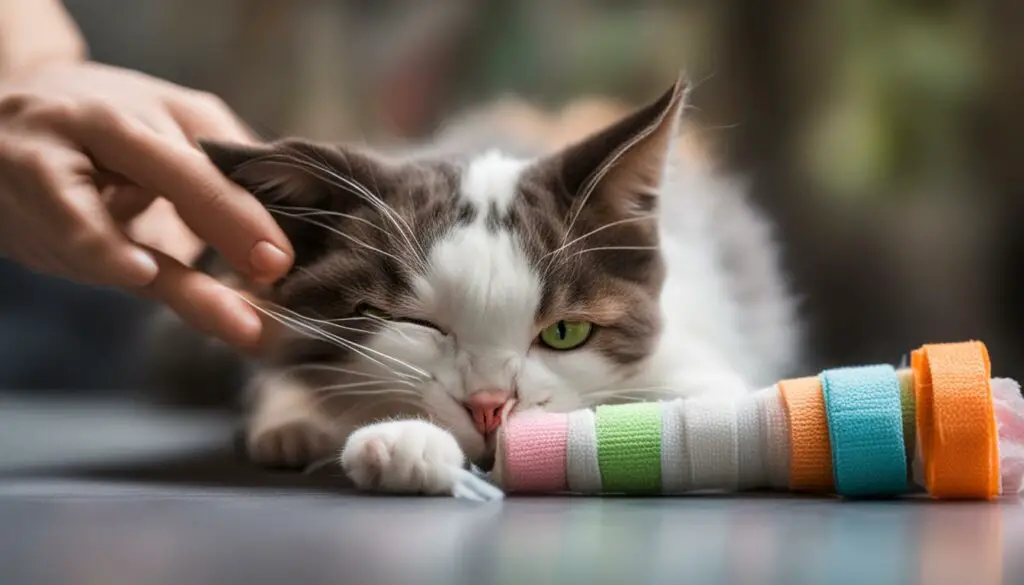
Table: Comparison between different methods of covering the wound without using a cone
| Method | Advantages | Disadvantages |
|---|---|---|
| Recovery Body Suits | – Specifically designed for cats – Provides secure and comfortable covering – Reduces the risk of infection |
– May be more expensive than other options – Limited availability depending on location |
| T-shirt/Onesie/Sock | – Cost-effective and easily accessible – Can be customized to fit the cat’s size – Allows for flexibility in securing the covering |
– Requires frequent checking and readjustment – May cause discomfort if not secured properly |
By choosing an appropriate method to cover the wound, pet owners can effectively prevent licking and promote a safe and comfortable recovery for their feline friends.
Distractions for Cats
Keeping cats distracted can be an effective way to prevent them from biting or licking their stitches after surgery. By providing engaging toys and activities, you can redirect their attention away from the wound and promote a faster recovery. Here are some ideas for distractions that can help:
- Catnip toys: Catnip is known to have a stimulating effect on cats, making it an excellent choice for diversion. Offer catnip-infused toys to keep your furry friend entertained and focused on something other than their stitches.
- Puzzle toys: These toys are designed to provide mental stimulation for cats. Fill them with treats or kibble to encourage your cat to work for their reward, diverting their attention away from their stitches.
- Stuffed Kongs: Kongs are versatile and long-lasting toys that can be filled with wet or dry food, creating a challenge for your cat to extract the tasty treat. The process of licking and working to get the food out can keep them entertained and less interested in their stitches.
Providing distractions like treats, toys, or extra cuddles when the cat tries to lick the wound helps them associate licking with a less satisfying outcome.
– Dr. Emily Johnson, DVM
It’s important to choose distractions that are safe for your cat and don’t pose a choking hazard. Supervise your cat during playtime to ensure they are using the toys appropriately and not causing further harm to their surgical site. By offering engaging distractions, you can help your cat recover comfortably and prevent any complications from licking or biting their stitches.
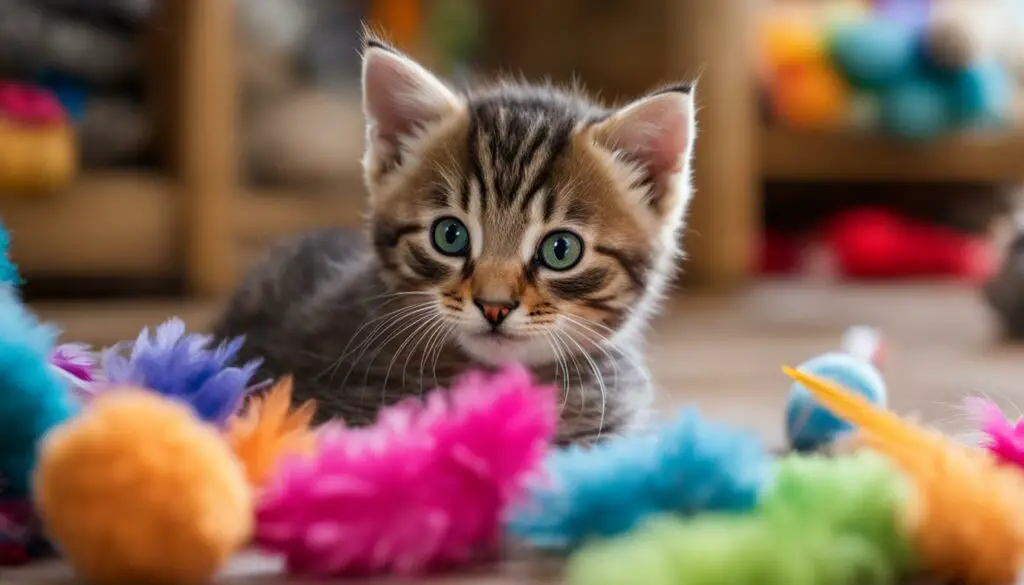
Summary
Distractions play a crucial role in preventing cats from biting or licking their stitches after surgery. By providing toys, treats, and interactive activities, you can redirect your cat’s attention away from their wound and promote a faster and more successful recovery. Remember to choose distractions that are safe and appropriate for your cat, and supervise them during playtime to ensure they are not causing any harm to their surgical site. With the right distractions in place, you can help your cat heal comfortably and minimize the risk of complications.
Using a Sock to Prevent Licking
One simple and cost-effective home remedy to prevent cats from licking their wounds is to use a sock. By repurposing a clean sock, you can create a makeshift collar that will cover and protect the wound, helping to prevent irritation and infection. To create the sock collar, start by cutting off the end of the sock that would normally cover the foot. This will create a circular opening for the cat’s head. Next, make small openings in the sock for the cat’s legs, ensuring they are large enough for a comfortable fit.
The sock collar can be gently slipped over the cat’s head, with the wound positioned in the center of the circular opening. The collar should fit snugly but not too tightly, allowing the cat to move comfortably while preventing access to the wound. It’s important to regularly check the collar for any signs of discomfort or tightness, and adjust or remove it if necessary.
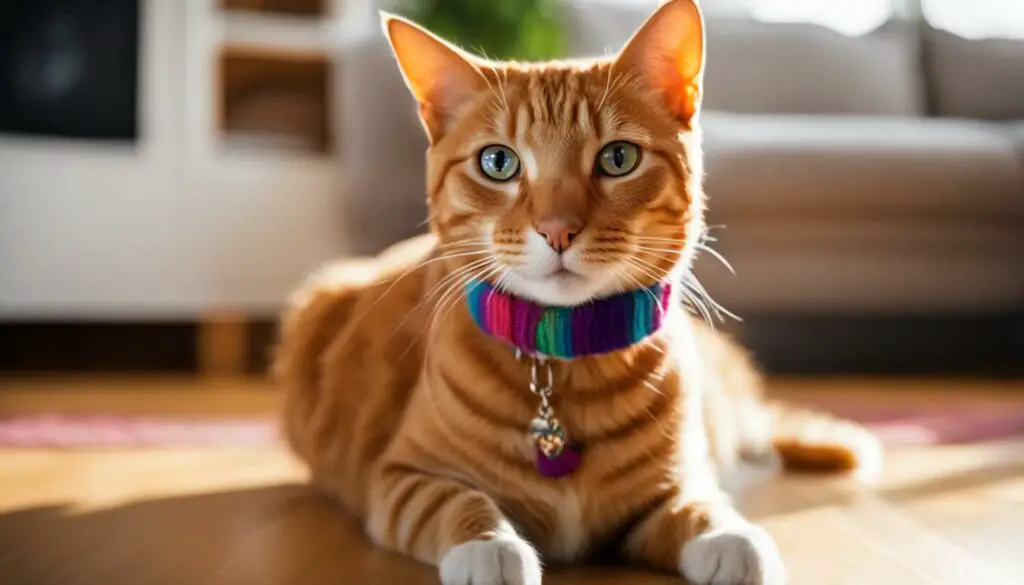
Using a sock as a collar can be particularly effective for small cats and kittens, as it provides a secure and protective barrier without restricting their movement excessively. However, it’s important to note that this method may not be suitable for all cats or wounds, and it’s always best to consult with a veterinarian for personalized advice on post-surgery care.
Preventing Cats from Licking Wounds Without a Cone Collar
When it comes to preventing cats from licking their wounds without the use of a traditional cone collar, there are several alternative options to consider. These options not only provide comfort for the cat but also effectively protect the wound and promote healing. One such option is the use of bitter antiseptic agents sprayed directly on the wound. The bitter taste discourages licking while promoting a quick recovery.
Another alternative method is the application of wound dressings. While this technique requires skill to ensure proper placement and comfort, it can be highly effective in preventing licking and reducing the risk of infection. Regularly changing the dressing, keeping it clean and dry, and monitoring for any signs of discomfort or swelling are vital steps in this process.
A homemade cone or neck collar can also be created using easily available materials such as fabric or tube socks. These homemade alternatives can provide temporary protection for the wound, ensuring that the cat can still breathe comfortably while preventing access to the affected area.
Comparison Table: Alternative Methods to Prevent Licking
| Method | Pros | Cons |
|---|---|---|
| Spraying Bitter Antiseptic Agents | – Discourages licking – Promotes quick healing |
– Requires repeated application – May not be effective for all cats |
| Applying Wound Dressings | – Provides physical barrier – Reduces infection risk |
– Requires skill and regular monitoring – Potential discomfort for the cat |
| Homemade Cone or Neck Collar | – Easy to create – Allows comfortable breathing |
– Limited effectiveness – Requires regular supervision |
It is important to note that each cat may respond differently to these alternative methods, and it may be necessary to try multiple options to find the most effective solution. Additionally, consulting with a veterinarian is always recommended for guidance on the best approach for your cat’s specific needs.
With the right care and attention, it is possible to prevent cats from licking their wounds without the use of a cone collar. Whether it’s through the use of bitter antiseptic agents, wound dressings, or homemade alternatives, prioritizing your cat’s comfort and well-being is essential for successful wound healing.
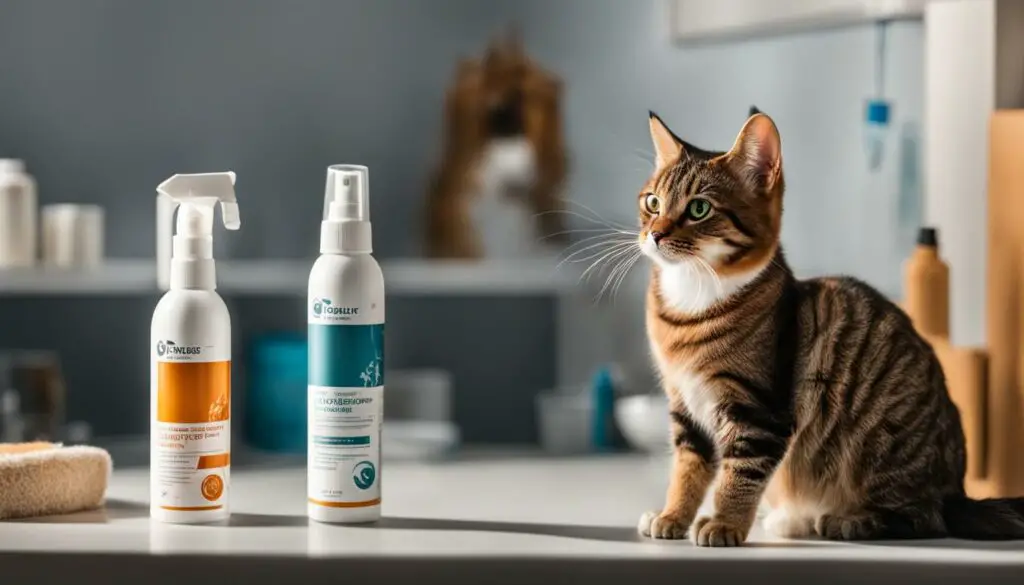
Applying Wound Dressings
When it comes to preventing cats from licking their wounds without using a cone, applying wound dressings can be a viable option. However, it is important to approach this method with care and skill to ensure that the dressing does not worsen the condition.
Firstly, it is vital to change the dressing daily to maintain cleanliness and prevent infection. Clean the wound gently with a suitable antiseptic solution, then pat it dry before applying the new dressing. Keeping the area dry is crucial for successful healing.
Additionally, regular checks are necessary to ensure the dressing is comfortable and not causing any adverse reactions. Look out for signs of discomfort, such as excessive scratching or swelling, as these may indicate that the dressing needs adjustment or a different approach altogether.
| Dressing Application Tips | |
|---|---|
| Change the dressing daily | Ensure cleanliness and prevent infection |
| Clean the wound gently with an antiseptic solution | Ensure proper hygiene |
| Pat the wound dry before applying a new dressing | Promote dry healing |
| Regularly check for comfort and swelling | Ensure the dressing is not causing any issues |
It is highly recommended to seek guidance from a veterinarian when applying wound dressings to ensure proper technique and appropriate materials are used. Their expertise will provide valuable insight and guidance tailored to the specific needs of your cat’s wound care without the use of a cone.
Redirection and Positive Reinforcement
When it comes to preventing cats from licking their wounds, redirection and positive reinforcement can be effective techniques. By offering distractions and reinforcing positive behaviors, you can train your cat to associate licking with less satisfying outcomes. Consistency and patience are key in this training method.
One way to redirect your cat’s attention away from the wound is by providing alternative activities. Safe chew toys, puzzle toys with treats, or stuffed Kongs can keep your cat busy and engaged. By offering these distractions when your cat tries to lick the wound, you can help them form a positive association that discourages licking.
Positive reinforcement is another important aspect of training cats not to lick their wounds. When your cat shows desirable behavior, such as leaving the wound alone, offer rewards such as treats, praise, or extra cuddles. This positive reinforcement helps reinforce the desired behavior and encourages your cat to continue behaving in that way.
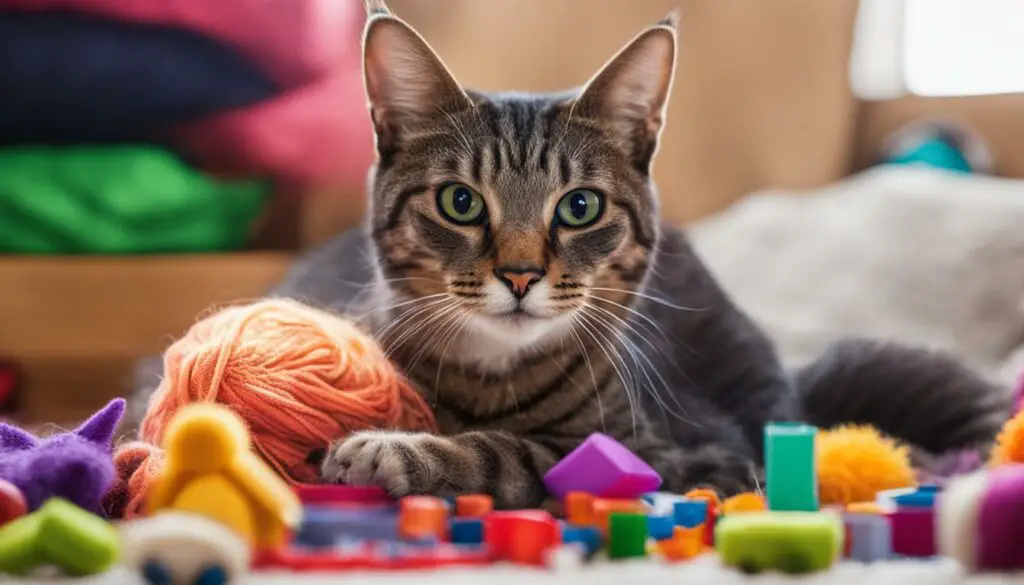 When implementing redirection and positive reinforcement techniques, it’s important to be consistent and patient. Training takes time, and it’s normal for cats to need repeated reminders and reinforcement. By using positive reinforcement and providing alternative activities, you can help your cat recover from surgery and prevent them from biting or licking their stitches.
When implementing redirection and positive reinforcement techniques, it’s important to be consistent and patient. Training takes time, and it’s normal for cats to need repeated reminders and reinforcement. By using positive reinforcement and providing alternative activities, you can help your cat recover from surgery and prevent them from biting or licking their stitches.
Homemade Cone or Neck Collar
If you find yourself in a situation where you don’t have access to pet shops or vet offices, you can create a temporary solution to prevent your cat from licking their stitches without a cone. A homemade cone or neck collar can be made from easily available materials such as fabric or tube socks. While these homemade options may not be as sturdy as professional collars, they can still provide some level of protection for your cat’s wound.
To make a homemade cone, you can use a piece of fabric or an old t-shirt. Measure the circumference of your cat’s neck and cut a circle out of the fabric, leaving enough space to comfortably fit around the neck. Cut a line from the edge of the circle to the center, creating an opening for your cat’s head. Wrap the fabric around your cat’s neck and secure it with safety pins or Velcro. Make sure the collar is secure but not too tight, allowing your cat to breathe comfortably.
Alternatively, you can use a tube sock to create a neck collar for your cat. Cut off the toe section of the sock and then cut two small openings on opposite sides of the sock near the top. These openings will be used to secure the collar around your cat’s neck. Slide the sock over your cat’s head, positioning the openings on either side of the neck. Pull the sock snugly around the neck, making sure it’s not too tight or too loose.
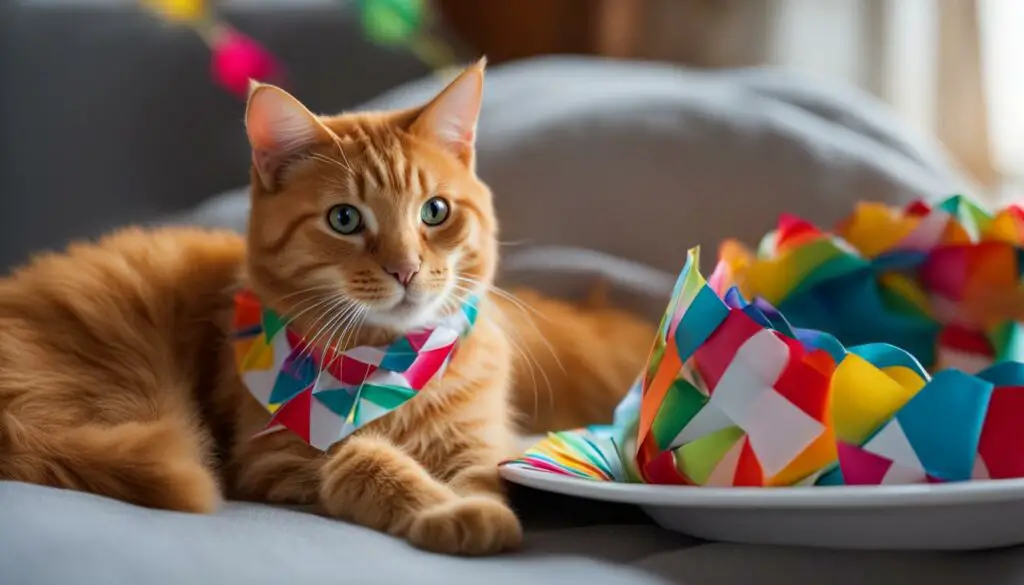
While these homemade options can provide a temporary solution, it’s important to monitor your cat closely to ensure they don’t remove or chew on the collar. If you notice any signs of discomfort or irritation, consult with a veterinarian to explore other alternatives for keeping your cat from licking their stitches without a cone.
Cat Saliva and Wound Healing
Contrary to popular belief, cat saliva does not have miraculous healing properties for wounds. In fact, cat saliva contains bacteria that can cause infection and hinder the wound healing process. When cats lick their wounds excessively, the mechanical abrasion from their rough tongues can further damage the delicate tissue, leading to delayed healing and increased risk of infection.
To prevent cat wound infection and promote proper healing, it is essential to take measures to prevent cats from licking their wounds. This can be achieved through the use of alternative collar options, covering the wound, providing distractions, and implementing positive reinforcement techniques.
By using alternative collar options, such as inflatable collars, soft E-collars, or neck brace collars, cats can be prevented from accessing their wounds and engaging in excessive licking. These collars are designed to be more comfortable for cats, promoting their overall well-being during the healing process.
Additionally, covering the wound with fabric or specialized recovery body suits can provide an extra layer of protection against licking. This method, when combined with the use of distractions such as safe chew toys or puzzle toys with treats, can redirect the cat’s attention away from the wound and discourage licking behavior.
Table: Pros and Cons of Preventing Cat Wound Licking Techniques
| Prevention Technique | Pros | Cons |
|---|---|---|
| Alternative Collars | – More comfortable for cats – Restricts access to wounds |
– May limit visibility for some collars |
| Covering the Wound | – Provides an extra layer of protection – Can be cost-effective |
– Requires regular cleaning and changing of fabric |
| Distractions | – Redirects attention away from the wound – Promotes mental stimulation |
– Requires supervision to ensure safety with toys and treats |
Preventing cats from licking their wounds is crucial for ensuring proper healing and reducing the risk of infection. By understanding the limitations of cat saliva and implementing effective preventive measures, we can support our feline friends in their recovery process and help them regain their health and well-being.
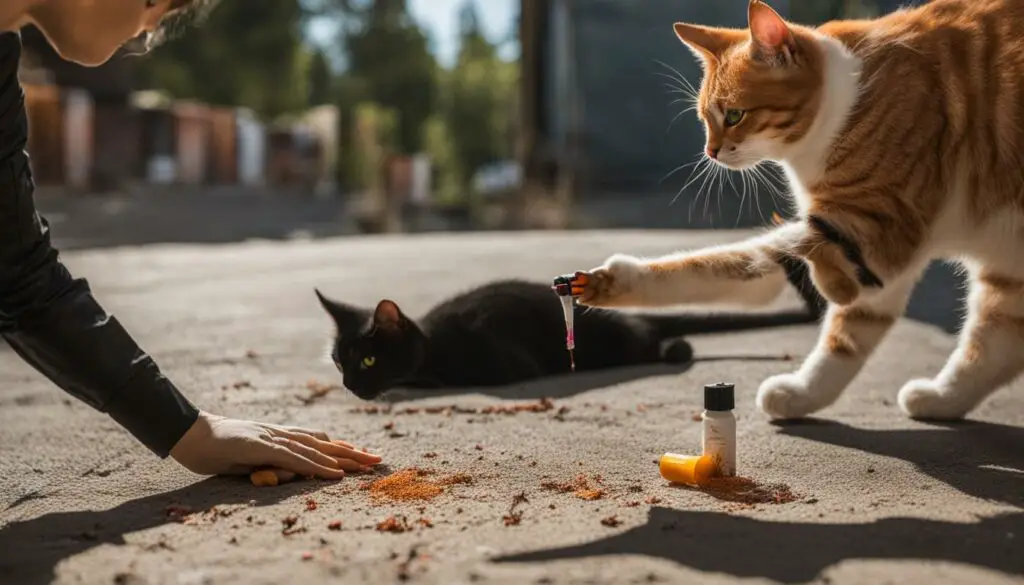
Section 15: Conclusion
In conclusion, preventing cats from licking their stitches without a cone is essential for their post-surgery care and wound healing. While traditional plastic cone collars are commonly used, there are alternative options available that offer comfort and effectiveness.
By utilizing inflatable collars, soft E-collars, neck brace collars, covering the wound with fabric, providing distractions, and implementing positive reinforcement techniques, cat owners can successfully prevent their furry friends from licking their wounds.
These alternatives not only help protect against infection and delayed healing but also allow for a more pleasant recovery experience for cats. It’s important to choose the right option based on the cat’s size and specific needs.
Remember, cat saliva does not possess miraculous healing properties and excessive licking can actually worsen the wound. By following the suggested methods and being consistent in their implementation, you can ensure your cat’s speedy and comfortable recovery without the use of a cone collar.
FAQ
How can I prevent my cat from licking its stitches without using a cone?
There are alternative options available, such as inflatable collars, soft E-collars, neck brace collars, covering the wound with fabric, and providing distractions for the cat.
Why do cats lick their wounds?
Cats instinctively lick their wounds, but excessive licking can delay healing, cause infection, and even remove stitches.
How do inflatable collars for cats work to prevent licking?
Inflatable collars restrict the mobility of the cat’s head, preventing them from reaching and licking their wounds. They are lightweight, soft, and provide greater visibility compared to traditional E-collars.
What are soft E-collars for cats?
Soft E-collars are fabric collars that provide a quieter and more flexible alternative to plastic E-collars. They are more comfortable for cats and come in various designs.
What are neck brace collars for cats?
Neck brace collars have a rigid plastic exterior and a soft, padded interior. They prevent cats from bending their necks and only allow for lateral head rotations.
Can I cover the wound with fabric instead of using a collar?
Yes, specialized recovery body suits or items like t-shirts or socks can be used to cover and protect the wound. Just make sure not to tape anything directly to the cat’s fur.
How can I distract my cat from licking its wound?
Providing safe chew toys, puzzle toys with treats, or stuffed Kongs can keep cats busy and redirect their attention away from the wound.
Can I use a sock to prevent my cat from licking its stitches?
Yes, by cutting off the end of a sock and creating small openings for the legs, the cat’s wound can be covered and protected. This method works well for small cats and kittens.
What can I spray on the wound to discourage licking?
You can spray a bitter antiseptic agent directly on the wound to discourage licking. However, make sure to read the instructions and consult with a vet to ensure it’s safe for the wound.
Can I apply wound dressings to prevent licking?
Yes, applying wound dressings can help prevent licking, but it requires skill to ensure the dressing doesn’t worsen the condition. Proper bandaging should be done with assistance from a veterinarian.
How can I train my cat not to lick its wound?
Redirection and positive reinforcement can be used to train cats not to lick their wounds. Offering distractions like treats, toys, or extra cuddles when the cat tries to lick the wound helps them associate licking with a less satisfying outcome.
Can I make a homemade cone or neck collar for my cat?
In the absence of pet shops or vet offices, homemade options can be created as a temporary solution. A homemade cone or neck collar can be made from easily available materials such as fabric or tube socks.
Is cat saliva beneficial for wound healing?
Contrary to popular belief, cat saliva does not have miraculous healing properties for wounds. It contains bacteria that can cause infection, and excessive licking can further damage the wound.
Source Links
- https://www.hepper.com/how-to-stop-cat-from-licking-wound-home-remedies/
- https://blog.healthypawspetinsurance.com/cone-alternatives-how-to-stop-your-pet-from-licking-wounds
- https://www.young-williams.org/post-op-licking-how-to-stop-it/

